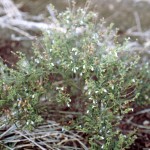Lanceleaf salvia
Salvia reflexa
Lamiaceae (Mint family)
Description
Lanceleaf salvia, also called Rocky Mountain sage, grows to about 2 feet tall, attaining a multistemmed, bushy stature. The square stems branch opposite each other at an upward angle. The narrow, lance-shaped leaves up to 2 inches long are also arranged opposite each other on short stems. Asymmetrical, blue flowers grow on spikes in whorls of two or three.
Habitat
These plants are found in the western two-thirds of Texas. They grow in dry fields, gravel-clay flats, slopes and rocky soils where there is little competition.
Toxic Agent
The toxic agent is unknown. Reported cases of poisonings in the United States are limited to cattle and horses that consumed contaminated hay. Experimental feeding trials have shown that sheep are also susceptible.
Although the plant has been proven toxic, it is not known how much of the plant material must be eaten to cause toxicity. In one confirmed case, alfalfa hay contained about 10 percent lanceleaf salvia.
Signs of Livestock Ingestion
Salvia poisoning is not common, and only general clinical signs are reported: Muscular weakness; Diarrhea; Colic.
Animals that die after consuming contaminated hay show postmortem evidence of gastrointestinal inflammation and liver necrosis.
Management Strategies
There are no documented reports of this plant causing poisoning under range or pasture conditions, although it has been suspected. Nevertheless, it has been proven toxic when consumed as a contaminant in hay and should therefore be considered potentially toxic to grazing animals. Look for this plant in hay as well as in hay fields before mowing.
Images
Plant Characteristics
Flower Color: Blue
Seed Type: Bean/Pod
Duration: Perennial
Stem Texture: Hairless/Smooth
Growth Habit: Forbs/Broadleaf
Leaf Shape
 : Simple with Pinnate or Parallel Venation
: Simple with Pinnate or Parallel Venation
Season: Warm
Distribution
 : 04 - Blackland Prairies, 05 - Cross Timbers and Prairies, 07 - Edwards Plateau, 08 - Rolling Plains, 09 - High Plains, 10 - Trans-Pecos
: 04 - Blackland Prairies, 05 - Cross Timbers and Prairies, 07 - Edwards Plateau, 08 - Rolling Plains, 09 - High Plains, 10 - Trans-Pecos
Distributions
Distribution refers to the ecological region in Texas that a plant has been found. You can also view a clickable map.
Book: Toxic Plants of Texas (B-6105)
Collection: Toxics, Wild Flowers
Livestock Affected: Cattle, Horses, Sheep
Livestock Signs: Abdominal Pain, Colic, Diarrhea




